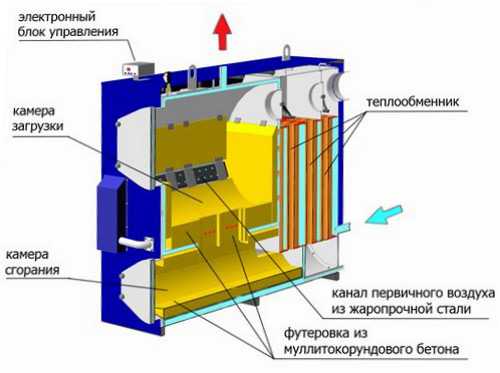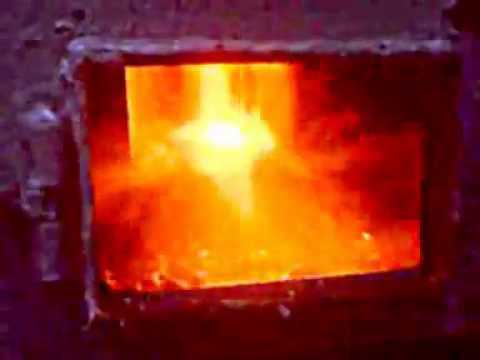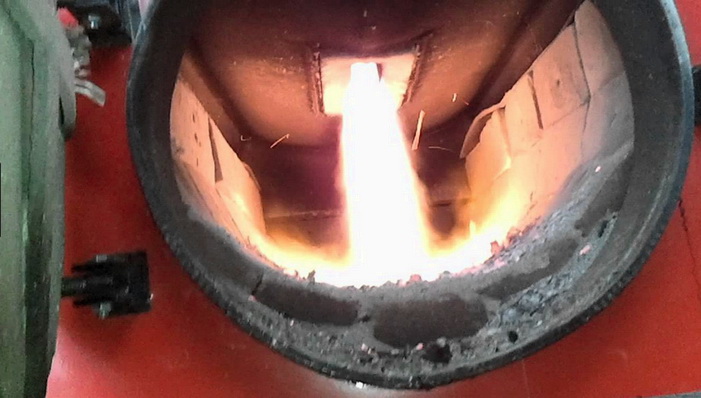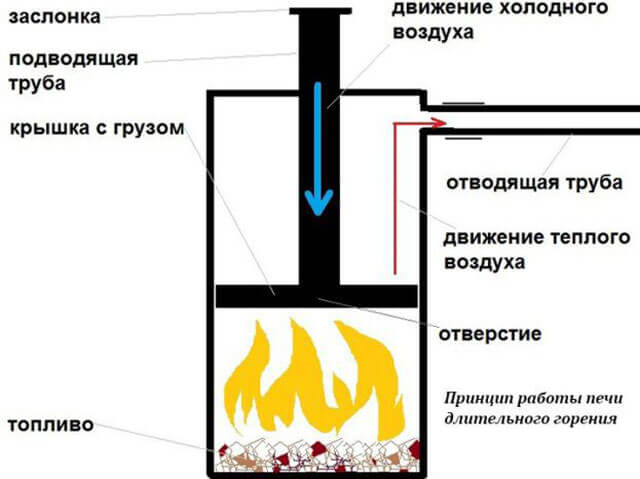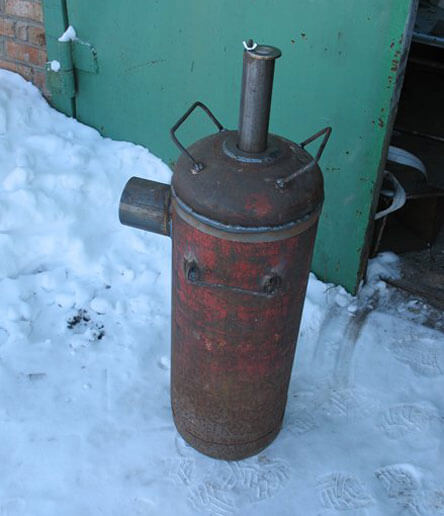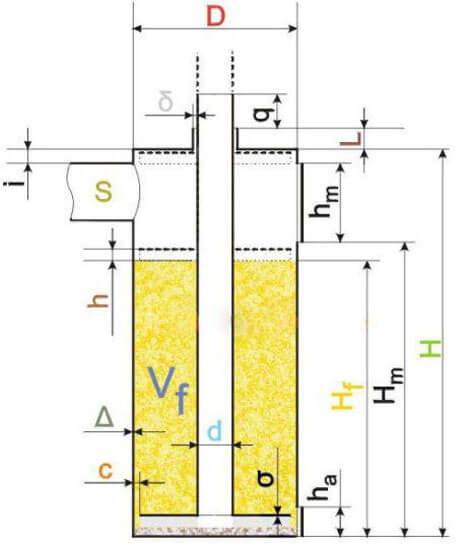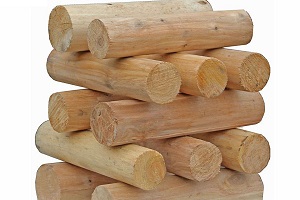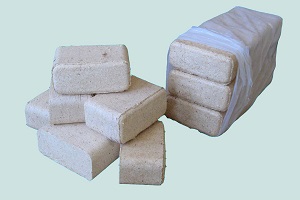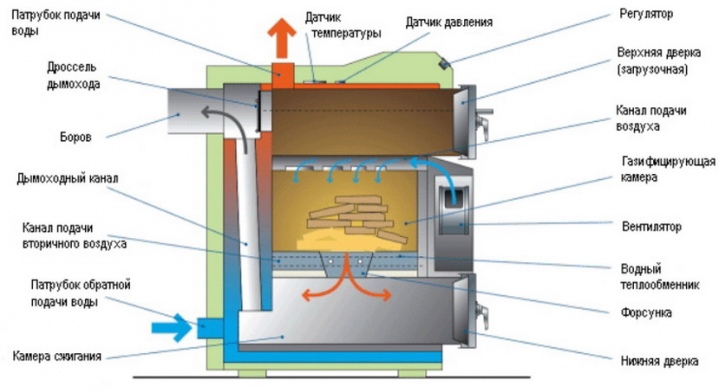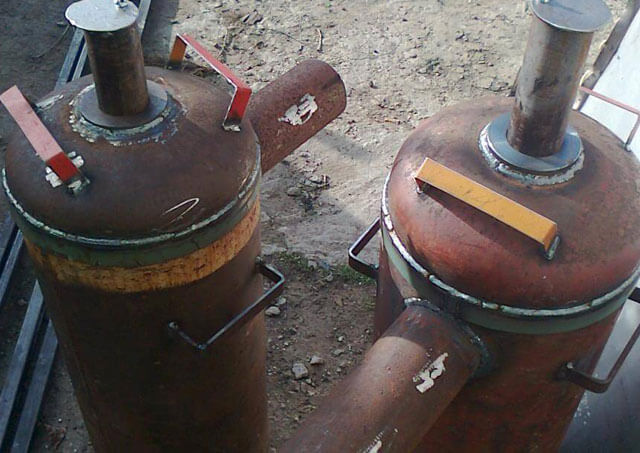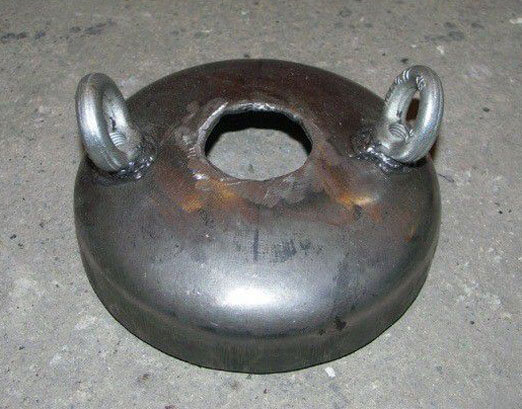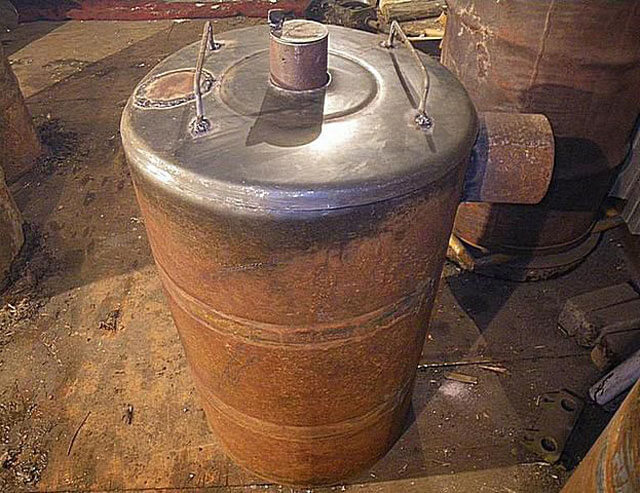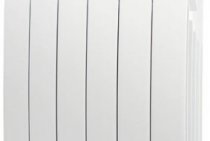Fuel
Pyrolysis boilers are efficient on fuel with a high volatile content - wood (firewood, wood waste, fuel briquettes and pellets), brown coal; some models consume coal (class "nut 1" or "stone") and even coke. This type of boilers makes rather high demands on the moisture content of the fuel - for firewood no more than 20-35%. This is due to the fact that water vapor dilutes the pyrolysis gases and interferes with combustion (see below), when working on wet fuel, the power drops sharply or the boiler goes out altogether. In situations where dry fuel is not available, this is a serious disadvantage.
This is interesting: Wall-mounted gas heating boilers
Pancake thickness
This value is in inverse proportion to the inner diameter D. It is necessary to achieve optimal piston pressure on the fuel insert. If the pressure is insufficient, this will lead to a decrease in the reverse action factor. As a result, the firebox may re-ignite with further smoke escaping through the chimney. If the piston is very heavy, this will significantly reduce the air gap necessary for high-quality combustion: as a result, the flame will die out.
The ratios between the inner diameter and the thickness of the pancakes are approximately as follows:
- 30 cm - 6-10 mm.
- 40 cm - 6-8 mm.
- 60 cm - 4-6 mm.
- 80 cm - 2.5-4 mm.
The device and principle of operation of the boiler
It has already been said earlier that boilers of this type have chambers. The furnace is divided into a gasification chamber into which fuel is loaded and directly into a combustion chamber.
The diagram shows the internal structure of a pyrolysis-type solid fuel boiler
Fuel is loaded into the first chamber, where the air flow is limited. The boiler starts up and works normally. With slow combustion, the fuel begins to pyrolyze, wood gas is released, which enters the second part of the furnace, into the combustion chamber. From this moment, the solid fuel boiler goes into operation. Now begins the processes that fundamentally distinguish the pyrolysis type of combustion, long-burning solid fuel heating boilers from the direct combustion process and from traditional boilers.
In the first chamber, heat loss is minimized. Usually, in models of solid fuel boilers for long burning, the space between the first and second chambers is filled with grates, on which fuel is placed.
The second part of the firebox is the combustion chamber, where combustible wood gas enters. The chamber is filled with secondary, heated air. The principle of double blowing is already in effect here.
After the boiler enters the normal operating mode, air access to the first chamber is significantly limited. The combustion process practically stops, turning into a state of smoldering. Fuel burns out gradually. Each previous layer of fuel in the smoldering process gradually involves the next layer. Slow smoldering is accompanied by a constant release of wood gas. Due to this process, solid fuel pyrolysis boilers are also called long-burning boilers.
In the second, main combustion chamber, only wood gas burns, which, when in contact with secondary air (heated up to t 3000 C), gives a huge amount of thermal energy. Only now thermal energy comes into operation, heating the coolant circulating in the heat exchanger. That is, in the design of solid fuel boilers of the pyrolysis type, the heating of the coolant is carried out not due to the direct combustion of solid fuel, but already due to the combustion of the secondary combustion product - pyrolysis gas, a combustible gaseous substance. This is the main difference between this type of boilers and solid fuel boilers of other types.
What is meant by pyrolysis
Pyrolysis - the generation of combustible gas and its subsequent combustion - occurs in all solid fuel boilers, to a greater or lesser extent. The same process goes on in a conventional stove - when burning wood or coal, in some place there is not enough oxygen, carbon monoxide CO appears, then it finds the missing oxygen and burns out, releasing heat, turning from poison into ordinary carbon dioxide - CO2 .
As an experiment, back in the 1950s, a scheme of boiler equipment was developed, where at first the fuel smoldered with a lack of oxygen, then the resulting CO was burned in the secondary chamber. But the ideas were not implemented, as they did not give any advantages with significant disadvantages and were expensive.
Now in advertisements, poisonous carbon monoxide CO is called “wood gas”.
How to make a pyrolysis boiler with your own hands
The technological process of manufacturing a pyrolysis boiler of the principle of operation includes the performance of plumbing and welding.
Required materials and tools
For the manufacture of a high-quality unit, experience in working with the following tools is required:
- electric welding machine;
- electric drill;
- Angle Grinder;
- a set of locksmith tools - square, level.
Required materials and accessories:
metal:
- sheet, thickness 4 mm, 7.5 m²;
- pipe - 8 m (diameter 57 mm, wall thickness 3.5 mm);
steel strip (thickness 4 mm, width 20 mm) - 7.5 mp;
steel strip (thickness 4 mm, width 30 mm) - 1.5 mp;
steel strip (thickness 5 mm, width 80 mm) - 1 mp;
fireclay (refractory) brick - 15 pcs;
corrugated pipe 60 × 30 (wall thickness 2 mm) - 1.5 MP;
corrugated pipe 80×40 (wall thickness 2 mm) - 1 MP;
cutting wheel d 230 - 10 pcs.;
grinding wheel d 125 - 5 pcs.;
electrodes - 5 packs;
temperature sensor.
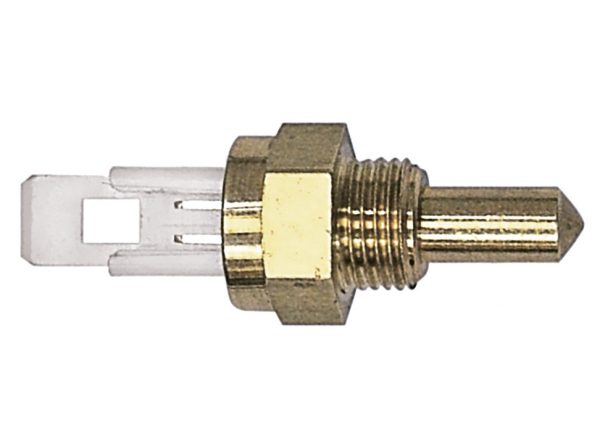
The temperature sensor is a mechanical device that controls the amount of air entering the combustion chamber.
The productivity of the boiler depends on the functioning of the flue pipe. To ensure good draft, the chimney must meet the quality requirements:
- height not less than 5 meters;
- good insulation;
- lack of sharp bends;
- condensate drain;
- easy access for cleaning.
Drawings and diagrams of the device
A pyrolysis boiler without forced ventilation has the simplest scheme. The energy independence of the design reduces the cost of operation of the unit.
The scheme of a pyrolysis boiler with a natural chimney looks like this:
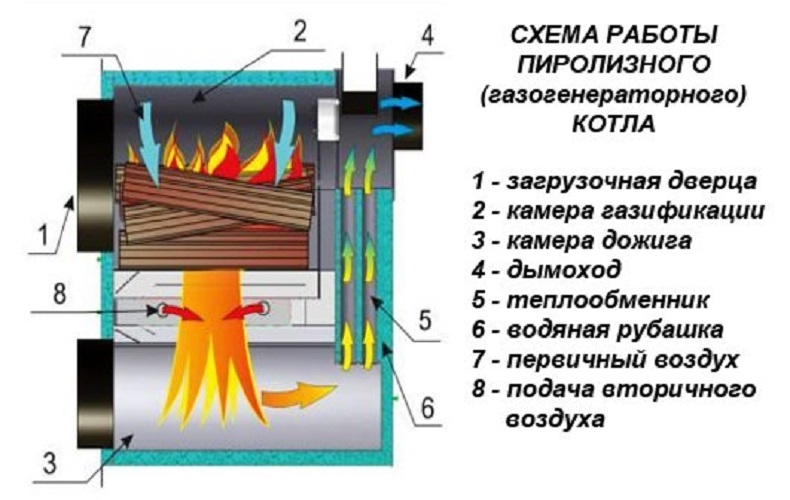
The boiler consists of three main chambers:
- loading, serving for throwing fuel;
- afterburner, where secondary air is supplied;
- heat exchanger going into the pipe.
Combustion of raw materials directs the flow of gas from top to bottom. When air is supplied under the grate to the array of fireclay bricks, the combustion of combustible gases occurs. The decay products go through the heat exchanger to the chimney. Draft adjustment is carried out by a temperature sensor at the outlet of the boiler using a chain connected to the secondary air supply damper.
Detailed detailing with dimensions and tolerances can be found in the standard drawing:
 A - boiler circuit controller; B - loading door; C - ash pan cover; D - chimney; E - coupling for the temperature fuse sensor; F - safety valve branch pipe; G - supply line of the circuit; H - cold water supply to the heat exchanger; L - return line of the boiler circuit; M - expansion tank
A - boiler circuit controller; B - loading door; C - ash pan cover; D - chimney; E - coupling for the temperature fuse sensor; F - safety valve branch pipe; G - supply line of the circuit; H - cold water supply to the heat exchanger; L - return line of the boiler circuit; M - expansion tank
Step-by-step instructions for manufacturing the unit
Making a pyrolysis boiler with your own hands is divided into stages:
- According to the drawing, the marking and cutting of parts for the body is carried out. After "tacking" the elements, a control measurement is made, then welding seams are made.The rear panel and side walls installed in their places are welded on both sides, cleaned, processed with welding sealant.
- Heat exchanger pipes are being installed.
- After welding the outer wall and the door shells, a mechanical coolant control regulator is installed.
- The chimney is assembled by building up the pipe. The next part must be inserted inside the previous one so that condensate does not get to the outside. The finished structure is painted with refractory paint.
The principle of operation of the pyrolysis boiler
 The chemical process of wood decomposition under high temperature exposure (from 200 to 800 ° C) with limited oxygen access is called pyrolysis.
The chemical process of wood decomposition under high temperature exposure (from 200 to 800 ° C) with limited oxygen access is called pyrolysis.
The operation of the pyrolysis boiler is based on the principle of dry distillation. Heating wood with a lack of oxygen leads to the formation of wood coke and gas. The resulting gas ignites when mixed with oxygen. At the same time there is an interaction with carbon. The combustion products leaving the boiler contain a reduced amount of harmful substances. The solid part of the wood, burning, releases thermal energy.
The pyrolysis effect can be obtained from the combustion of fuels of various types:
- firewood (bars no larger than 450 × 250 mm);
- chopped branches;
- briquettes;
- sawdust;
- pellets (wood pellets);
- peat;
- coke;
- coal.
Wood is the most efficient type of fuel, producing a large amount of pyrolysis gas. Branches and sawdust can be mixed with firewood in an amount not exceeding 25% of the total volume in order to maintain the efficiency (coefficient of performance) at a high level.
The difference between the device of pyrolysis boilers from traditional ones is the presence of two combustion chambers: fuel (gasification) and combustion.

The designs of pyrolysis boilers differ depending on the method of air supply: natural, using chimney draft, and forced, blowing air with a fan.
In natural draft installations, the secondary chamber is located above the main firebox and the air flow is from bottom to top. With artificial draft, the opposite is true: the main furnace is under the secondary chamber and the air direction is from top to bottom.
Why is it needed
Pyrolysis boilers are becoming increasingly popular due to the rising cost of other energy sources. Space heating is getting more and more expensive. Wood is the cheapest type of fuel for traditional boilers, but it takes a lot of it.
The use of additional energy from the combustion of gas released during the pyrolysis of wood allows you to get much more thermal energy.
Compared to boilers operating on other types of fuel, pyrolysis devices have the following advantages:
- reduction of air consumption for the gas combustion process;
- less waste - soot and ash;
- a 3-fold reduction in the release of harmful substances and components;
- increase in the operating time of the boiler (time interval between fuel loads (up to 12 hours);
- the ability to adjust the performance of the boiler within 30–100%;
- facilitating the process of controlling the combustion of pyrolysis gas.
Features of a long burning stove
The first step is to understand what happens during the burning of firewood. For the appearance of a flame, the temperature of the wood must be brought to approximately +150 degrees, using an external heating source for this. Usually, a piece of paper lit from an ordinary match is enough for this. After that, the process of slow carbonization of the material begins, which, after reaching the mark of +250 degrees, turns into decay into simple chemical elements. The composition of the white smoke that appears when the flame is ignited includes gas and water vapor: they exude heated wood.The ignition of the released gaseous components is observed when heating reaches +300 degrees: as a result, the thermochemical reaction is significantly accelerated.
The breakdown of organic matter into simpler elements is called pyrolysis. Practice shows that during the combustion of wood, part of the energy potential embedded in it remains unused. This is expressed in a significant amount of waste remaining after the extinction of the flame. In pyrolysis furnaces, fuel is used much more efficiently, which is achieved by separate combustion of the gases released during the combustion of the fuel. At the same time, the rate of smoldering of the wood itself is very small, which contributes to an increase in the duration of the furnace on one tab. The Bubafonya stove, which is a type of pyrolysis heater, guarantees almost complete combustion of all fuel.
Long-burning pyrolysis boilers with a water circuit

Long-burning pyrolysis boilers with a water circuit are an excellent alternative source of energy in private homes in conditions of frequent gas supply interruptions.
A long-burning solid fuel boiler with a water circuit can run on wood and other types of solid fuels: coal, wood waste, etc.
The main disadvantage of this type of boilers is the high price. In addition, unlike many other types of boiler equipment, a long-burning pyrolysis boiler with a water circuit is most often volatile.
Not only the circulation pump and control devices are powered by electricity, but also the built-in fan: this equipment, as a rule, does not work on natural draft.
Solid fuel wood and coal boilers are second only to gas boilers in popularity. At the same time, they have one serious drawback - fuel loading must be carried out several times a day.
With the usual combustion of firewood, the efficiency of boilers does not exceed 75%, and part of the combustible substances simply flies into the chimney.

Long-burning pyrolysis boilers with a water circuit are much more practical and efficient.
It will not be a secret for anyone that pyrolysis heating boilers are currently very necessary and popular devices for heating systems. It is for this reason that many of our people began to be interested in these particular units.
A pyrolysis boiler is a special heating boiler that can use pallets, coal, wood, and other materials as fuel.
One of the main criteria, depending on which heating boilers are divided, is the type of fuel on which they operate. Thus, in today's market you can find boilers on pallets, coal, firewood. You can also find the so-called universal boilers for yourself.

The most common at the moment are wood-burning solid fuel boilers, which have many advantages. The first is that the fuel is considered the most affordable. It should also be noted that such boilers are sold at affordable prices.
A distinctive feature of pyrolysis boilers is the control of the oxygen level in the combustion chamber, and, accordingly, the control of the temperature and rate of combustion of the fuel. A solid fuel pyrolysis boiler will ensure your independence from gas and electricity, since the costs of these energy sources significantly exceed the cost of solid fuels.
This is interesting: How to fill a self-leveling self-leveling floor - we explain it step by step
Foundation construction
The foundation for the Bubafonya stove is laid in this way:
- The first step is to dig a square hole. Its approximate dimensions are 150x150 cm, with a depth of 20-30 cm.
- The bottom of the trench is covered with a crushed stone pillow and poured with a concrete solution. To level its surface, a trowel is useful. When the flooded area seizes, it is necessary to check the horizontalness of its surface using the building level.If necessary, additional adjustments are made.
- On top of a completely dried concrete stand, refractory bricks are laid in several rows. Usually 2-3 layers are enough.
Strengths and weaknesses of Bubafoni
The pyrolysis stove has a number of positive qualities:
- Simplicity of design. Having welding skills and experience working with metal, it will not be difficult to build a stove.
- Universalism. Bubafonya is very unpretentious in terms of fuel: firewood, coal, sawdust, wood chips and other types of wood waste can be thrown into it. Also, the stove copes well with pellets - inexpensive eco-friendly granules.
- Duration of work. The burnout time of one bookmark of firewood is almost a day: during this time, the stove regularly generates heat. This indicator may vary depending on the modification of the device, the volume of its furnace, the rate of oxygen circulation, etc.
Mention should also be made of the main disadvantages of Bubafoni:
- Low efficiency. The reason for this is the uneven heating of the device case with a sufficiently low heat transfer. More "advanced" pyrolysis furnaces are much more efficient in this regard: their efficiency often exceeds 90%.
- Inconvenient cleaning. As such, there is no ash pan in the design, so the remains of combustion products are removed through the top. Some modifications of the furnace are equipped with a door at the bottom, which facilitates the procedure for cleaning up ash and ash.
- Low aesthetics. The appearance of Bubafoni can hardly be called beautiful, so it is mainly used for heating utility rooms.
Drafting
The main proportion in the course of manufacturing a homemade Bubafonya stove from a gas cylinder is the mathematical ratio of the parameter of the inner diameter of the body and its height. It should be between three and five to one. The optimal diameter value is from 30 to 80 cm.
Making the diameter of the furnace body less than 30 cm is not effective, since oxygen will circulate too quickly through the combustion chamber without fully reacting with firewood. This leads to a noticeable decrease in the efficiency of the device. In chambers with a diameter of more than 80 cm, another problem arises - in it, firewood burns very slowly at the edge, and faster in the center. As the fuel burns out, a dip occurs, into which the piston sinks. As a result, the flame is gradually extinguished. In the drawing, it is more convenient to denote the diameter with the letter D, and the height - H.
Fuel types
Aspen eurofirewood
One of the most positive properties of pyrolysis boilers is that they are able to operate efficiently on any solid fuel.
It can be black and brown coal, as well as wood and peat, etc.
Of course, on each of these types of fuel, the pyrolysis boiler is able to operate for a certain time until the moment when it burns out completely.
The combustion times for different fuels are as follows:
- brown coal - 8 hours;
- hardwood - 6 hours;
- soft wood - 5 hours;
- black coal - 10 hours.
As observations show, the most efficient fuel for a pyrolysis boiler is dry wood. It, with a length of 45-65 centimeters, allows the boiler to function most efficiently and increase its operation time.
But if these types of fuel are not available, any type of fossil fuel can be used.
Fuel briquettes
Of course, if it is allowed for use in such a boiler.
Permitted fuels include:
- briquettes and pellets for heating;
- wood waste;
- industrial waste containing cellulose;
- some varieties of peat.
When heating, it must be taken into account that if the flow of primary and secondary air is selected correctly, and the humidity of the air is not higher than the permissible one, then no by-products will be released during combustion.
Be careful: if the humidity is high, then strong water vapor will inevitably be released, which means that tar and soot will inevitably appear, the calorific characteristics of the gas will deteriorate and the boiler may die out.
Scheme, features of work
For the second time, in the 2000s, when the average manufacturer had sufficient production capabilities and materials, production began at the household level. False aroused interest in the consumer - sales and profits appeared.
The scheme of the pyrolysis boiler is usual - in a large chamber, the laying of firewood first flares up, then the automation shuts off the air and, if there is a shortage of it, the firewood smolders for a long time. The released carbon monoxide and a large amount of ash particles - pure carbon C is mixed with heated air in the secondary chamber, where they burn out.
In this burner, there is always a reddish flame - a direct sign of a reaction involving carbon.
How to increase the efficiency of the pyrolysis oven
Basically, the efficiency of Bubafoni is reduced due to uneven heating of its case; this leads to a deterioration in the efficiency of heat exchange between the device and the surrounding space. There is a fairly simple way to optimize the process using corrugated metal sheet. An impromptu shirt for the body is made from it: it is fixed over the cylinder by welding or twisting.
Another popular option for increasing the efficiency of a pyrolysis furnace is the Bubafonya boiler with a water jacket. Most often, the water circuit is made from a metal barrel or box, pouring water into them. By placing a red-hot Bubafonya inside the fabricated structure, it is possible to achieve heating of the water and put it inside the heating system. Thus, it is possible to acquire a kind of boiler for heating a large room.
When creating a water jacket, it is necessary to take all necessary measures to make it as reliable as possible. If a box is used for these purposes, it must be well welded to avoid leaks. It is advisable to seal all seams with a heat-resistant sealant. The recommended thickness of the steel sheet for the manufacture of the water circuit is at least 3 mm. It is best to close the top of the box with a lid with handles. The Bubafonya long burning furnace with a water jacket can be additionally equipped with a heat exchanger consisting of thin tubes.
There are several useful tips for better and safer operation of the stove from a long-burning gas cylinder:
- It is best to install the device indoors on a sheet of metal.
- The space around the oven must be cleared of any flammable objects.
- When igniting the fuel, it is not recommended to abuse the flammable liquid.
- The body of the product is quite hot, therefore, when servicing the heater, it is necessary to put on thick gloves.
- To extinguish the flame, the damper on the air pipe closes.
- It is strictly forbidden to paint Bubafoni parts.
A homemade pyrolysis oven from a gas cylinder is one of the most popular manufacturing options. It captivates with its cheapness and simplicity. All materials are easily found in any cottage.
She will not heat a large house, but for a small cottage, garage, greenhouse - that's it.
Such a stove can easily cope with heating a room of 100 m 2. Often used for heating greenhouses, garages, warehouses. It does not require a foundation, but the foundation still needs to be prepared. As a minimum, level and cover with a metal sheet, at least 4 mm thick.
It is also important to comply with all fire safety rules during installation. The distance to combustible objects should not be closer than 50 cm
Wooden surfaces are additionally protected with a fireproof cloth.
Furnace operation
Before igniting Bubafoni, the welded air duct must be removed from the inside of the body, after removing the top cap.Inside the stove, wood logs are laid in a horizontal position, right next to each other. When stacking vertically, there may be some obstacles in the way of the piston movement: this usually occurs in cases where the logs do not completely burn through. As a result, smoldering in the primary chamber will develop into full-fledged combustion, which seriously disrupts the proper functioning of the furnace. In this case, firewood is consumed much faster, and smoke begins to seep out of the duct. When laying logs, it is forbidden to block the area where the chimney is welded.
A layer of chips, sawdust or chopped branches is poured onto the firewood. On top of them you need to put an old cloth or paper soaked in kerosene. A piston is installed end-to-end on the fuel bookmark and a cover is put on. To set fire to firewood, you need to set fire to a piece of rags or paper, and throw it inside through an air pipe. Matches in this case are ineffective, as they go out before they reach the fuel. After the firewood is lit, they pause for 15-20 minutes, allowing them to flare up well. When the flame gains strength, the valve on the air pipe should be closed: in this way, Bubafonya is transferred to the main operating mode.
A bit of history
The development of the Bubafonya stove is attributed to the craftsman Afanasy Bubyakin from Kolyma. Subsequently, a new invention was named in his honor. Athanasius, during his experiments, repelled from the device of the Lithuanian-made Stropuva pyrolysis boiler.
The domestic inventor tried to simplify the design as much as possible so that it could be built with his own hands. This specificity of Bubafoni explains its high popularity. Given that the material for the manufacture of this device is mainly improvised means, it cannot boast of external aesthetics. The strengths of the stove are its simplicity, efficiency and reliability.
Pyrolysis boiler from a gas cylinder instruction
This design is popularly called Bubafonya. Such a nickname was the inventor-craftsman from Kolyma, who was the first to post the idea on the net.
The movable piston divides the combustion chamber into two segments: firewood burns below and pyrolysis gas burns out from above.
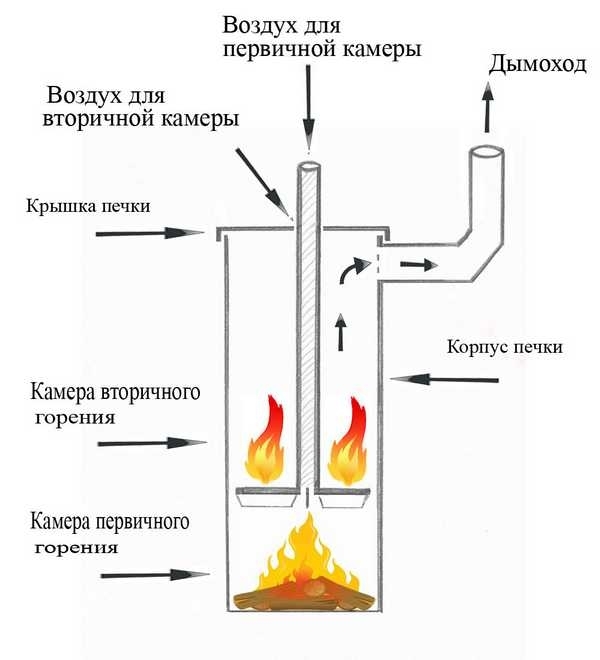
Air movement is directed from top to bottom. Burning is much slower than in a traditional boiler.
Oxygen enters through a pipe that serves as a rod for the piston. To burn the pyrolysis gas, oxygen enters through holes where the piston tube is inserted into the cap. The connection must not be tight. The separation of the chambers ensures the burning of the entire volume of fuel.
The intensity of combustion is controlled through a pipe connected to the piston ring. For convenience, a pin with a movable metal disk is welded to the pipe, the size of which is slightly larger than the diameter of the pipe. By adjusting the gap between the pipe and the disk, the desired temperature is achieved.
To make Bubafoni, you need the following materials:
- a cylinder with a volume of at least 50 liters;
- fittings;
- strip of metal (steel).
The device consists of parts:
Assembly and welding works
Perform assembly and welding work according to the instructions:
- Cut off the rounded part of the cylinder, getting the body and cover. Grind the cut points with a grinder. Cut out the fuel inlet on the side.
- From the reinforcement, make a grate through which burnt firewood will wake up.
- Make a piston: weld the blades to the iron disk on one side, the pipe on the other.
- Perform chimney installation. For better traction, you can use a gradual increase in the diameter of the pipe in the direction from the beginning to the end.
Coat the structure with refractory paint.
The combustion process sets the blades in motion. Air vortex flows are created, but the disk prevents the flame from increasing. The result is a pyrolysis effect from smoldering firewood for 8-10 hours.Fuel is loaded once a day.
Such a boiler can heat a large room. It works on different types of solid fuel:
Getting more thermal energy from wood makes the use of pyrolysis boilers more and more attractive. Having skills in plumbing and welding, you can make a pyrolysis heating unit with your own hands according to drawings and diagrams or from an old gas cylinder.
How to make a pyrolysis boiler with your own hands from a gas cylinder step by step instructions
To begin with, drawings of home-made pyrolysis boilers are required. They are found in the relevant literature or on the websites of home craftsmen.
It is important to consider units with detailed videos and reviews from real owners who improve their own invention during operation. Of the materials and tools you will need:
- Steel sheets and profile pipes from 3 mm thick. If it is less, then over time, the burning temperature of the firewood will deform the unit and render it unusable at the time of operation, which is fraught with the risk of burning the walls and the occurrence of a fire hazard.
- DC welding machine and related electrodes.
- Drill with diamond drills and grinder with similar discs.
- Boiler accessories: doors, ash box, blower fan.
Depending on the design and drawings, the models of the units differ. If you create a pyrolysis oven with your own hands - the heating device keeps heat better, unlike iron, then fireclay bricks and asbestos or paranite sheets are added to the described set.
An algorithm or step-by-step instruction consists of the following items:
- According to the intended dimensions, the prepared steel sheets and profile pipes are cut. The edges of the workpieces are carefully passed with a diamond grinding wheel - it will be easier to weld and the risk of injury will decrease.
- The body is welded - the end blank is laid on a horizontal surface, and the walls, bottom and lid are attached to it with tacks.
- Inside the boiler there is a firebox with a grate. In the middle, a nozzle is welded to remove waste olefins - gases with a high temperature.
- The cooling system is being assembled. It consists of several profile pipes extending beyond the boiler.
WATCH VIDEO
It remains to weld the front wall, equipped with a blower and loading door, onto the heating boiler with your own hands, install the unit on the appropriate frame and conduct tests.
They install the boiler with their own hands on a concrete plane, filled in level and covered with asbestos sheets. If there is no possibility for pouring - the weight of concrete affects the foundation, then the floors are dismantled, laid out with bricks, covered with paranit and covered with sheet iron. So, the safety of the impromptu boiler room will be observed. Making a pyrolysis boiler with your own hands is easy, you just need to try a little.
Design
Bubafonya long burning furnace includes the following units:
- Frame. The main element of the instrument, usually in the form of a cylinder. It is most often made from cylinders, barrels, large fire extinguishers, thick welded pipes, etc.
- The chimney through which combustion products are discharged. The material for its manufacture is usually a metal pipe with a diameter of 110-250 mm. It is fixed by welding on the top of the furnace.
- Piston. Ribs are welded onto the lower part of the metal circle: the duct pipe is fixed in its central part. Due to the ribs, an additional layer of air is created that separates the fuel and the piston. This makes the smoldering process more efficient and stimulates the active release of pyrolysis gases.
- Regulator. Thanks to this valve, oxygen is supplied into the furnace.
- Lid. It has holes for an air duct, forming a secondary combustion chamber in combination with a piston.Inside this compartment, pyrolysis gases are burned.
How is the assembly of the structure with a water jacket
The manufacture of the chimney is carried out in the following sequence of operations:
- Carefully cut the balloon at the top. The lid for the boiler is subsequently made from the resulting cap.
- The bottom of the cylinder is equipped with homemade legs. Before fixing, each of them must be set exactly according to the level.
The piston is constructed in three stages:
- A steel circle is cut out: in cross section, it should be inferior to the inner diameter of the cylinder by about 35-45 mm. Thanks to the side gaps, pyrolysis gases will seep into the secondary chamber without interference. A hole for the air duct is made in the center of the circle: this pipe must be inserted into it tightly enough.
- Next, a metal circle and a pipe are welded to each other.
- A piece of channel is welded over the piston base.
For the manufacture of the furnace cover, you can use the upper cut-off part of the cylinder. On its surface, markings are applied under the duct pipe with a fixed supply piston. In this case, it is necessary to provide a certain margin for the free movement of the pipe. Cutting is carried out along the drawn lines. On the side, a home-made lid is shaped with handles, for which fittings bent in a vice are used. Now you can start installing the chimney at the top of the makeshift pyrolysis oven. With the help of a grinder, a cutout is made for the pipe blank: welding is also used to fasten the parts.
On this, the main part of the work on the construction of Bubafoni is considered completed: it can be put into operation. It is desirable to install the furnace on a pre-equipped foundation.
conclusions
Having considered how to make different types of pyrolysis furnaces, we can summarize that it is realistic to make only a structure from a gas cylinder. You can’t build a brick oven on your own, it’s too difficult. A camping option from tin cans also has the right to exist, but it can only be made at home, this will not work in the field. And finally, the working furnace is simple, but dangerous, it requires very careful and accurate operation. The risk is quite high, so we do not undertake to recommend it for heating the garage.
With the onset of winter cold, the owners of private households, who bear full responsibility for heating their homes, add to the worries. In those premises where the power of the main heating is weak or it is absent at all (sheds, garages), it is necessary to look for inexpensive alternative methods.
Conclusions and useful video on the topic
This video clearly shows the principle of operation of the pyrolysis boiler:
A detailed overview of the operation of the upper combustion boiler can be found here:
Pyrolysis boilers are not cheap, but they fully justify the funds invested in their purchase. With proper installation and maintenance, such devices will provide the house with stable and inexpensive heat.
Are you looking for a pyrolysis boiler for heating your home? Or do you have experience with these units? Please leave to the article and share your impressions about the use of pyrolysis boilers. The feedback form is located in the bottom block.
How economical is the pyrolysis boiler
Let's calculate for the usual power of an average house, savings with a pyrolysis boiler. For example, let's burn in a conventional device for a season 7 months of firewood for 20 thousand rubles. At the same time, we will save about 1800 rubles on pyrolysis, - firewood consumption by 18200 thousand rubles.
But a fan with a power of 80 W., Having worked for 7 months at a price of about 5 rubles per 1 kW of electricity, eats more than 1,500 rubles. In total, the savings are no more than 200 rubles per year. Those. spent 50 thousand rubles will never pay off.
Even if somehow the savings are 1000 rubles (a miracle efficiency of more than 92%), 50 years is still not a serious payback period.The biggest maximum - the additional cost of boiler equipment should pay off in 10 years. Otherwise, it is not beneficial. There are no such indicators and close. What attracts the consumer's pyrolysis boiler at such a price is a large load!
